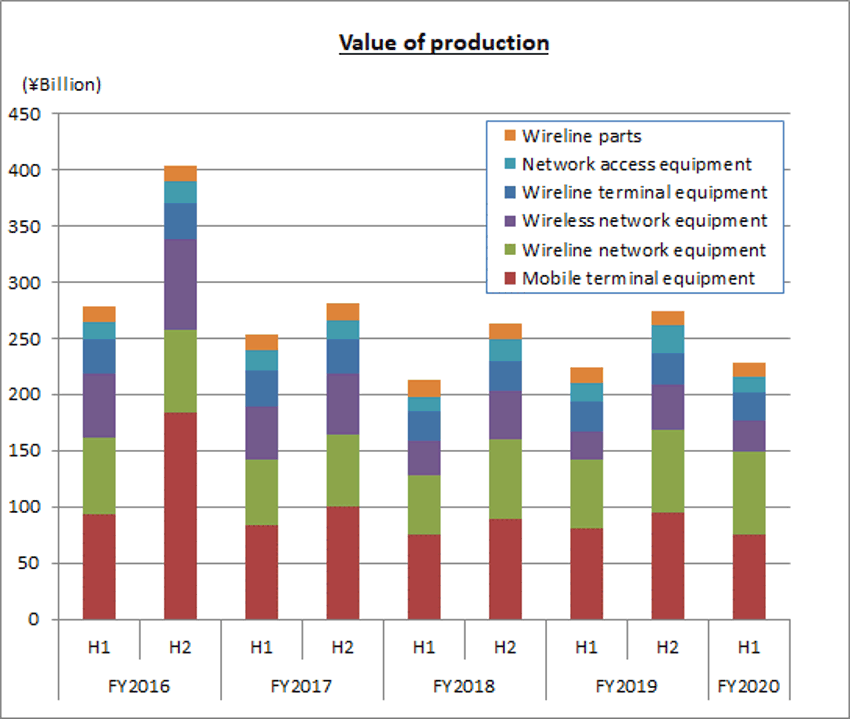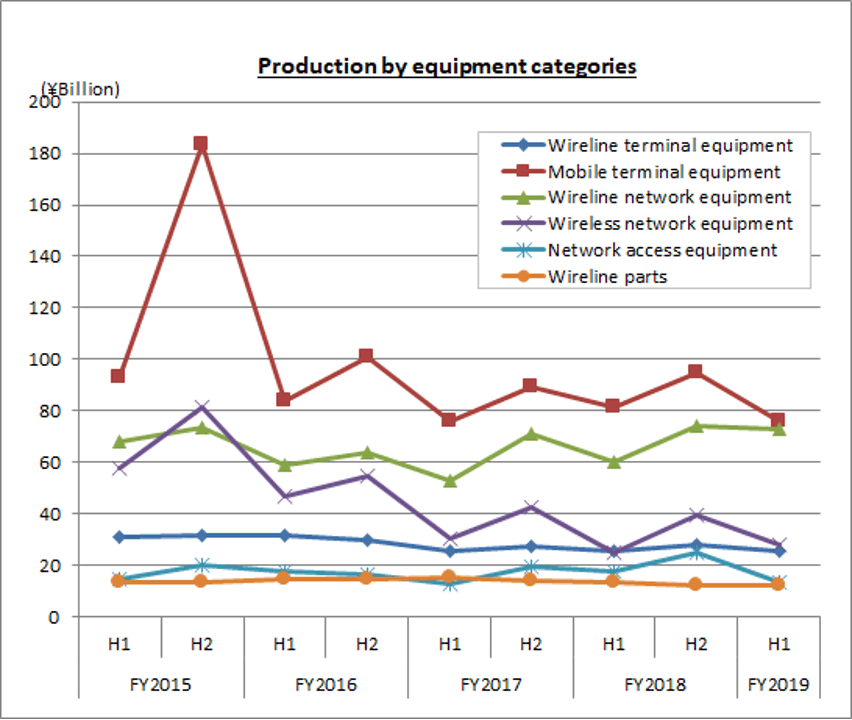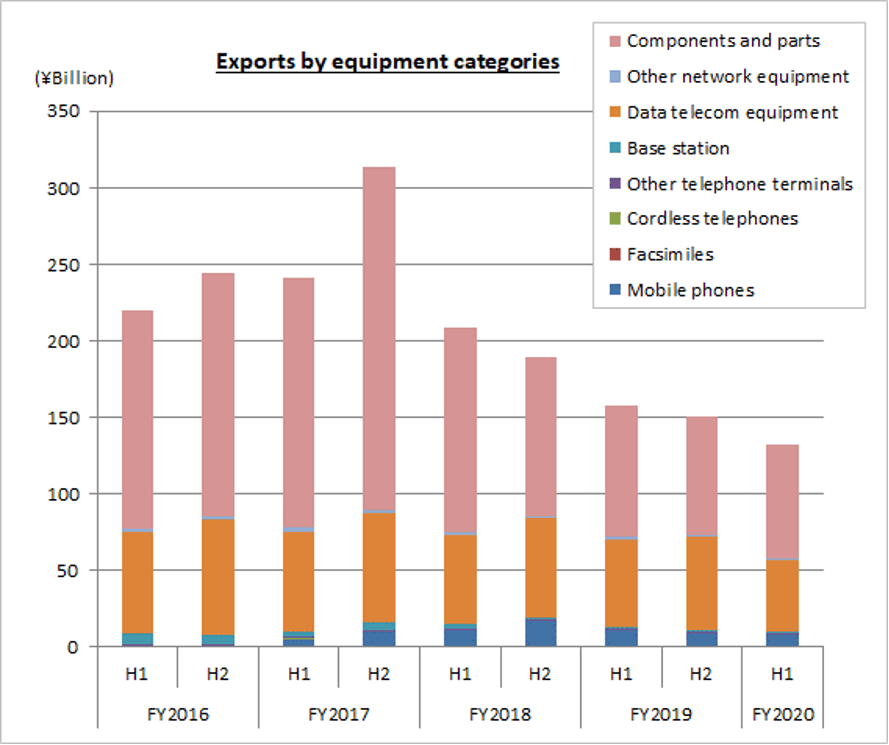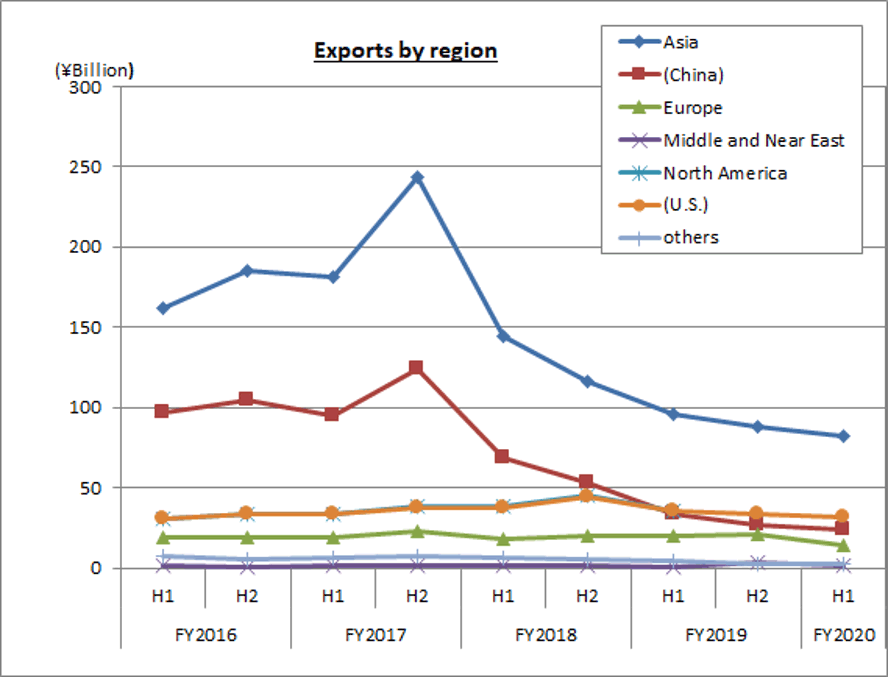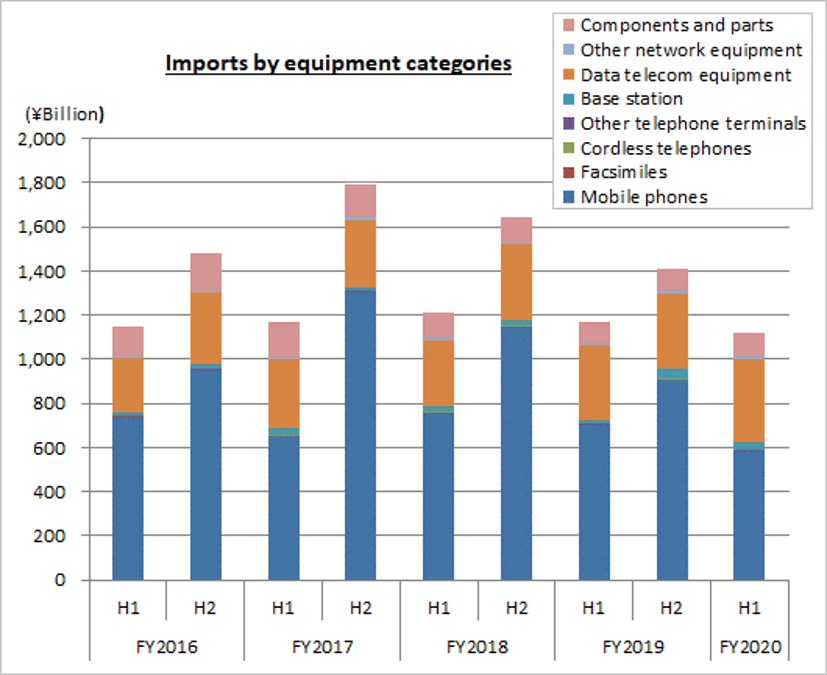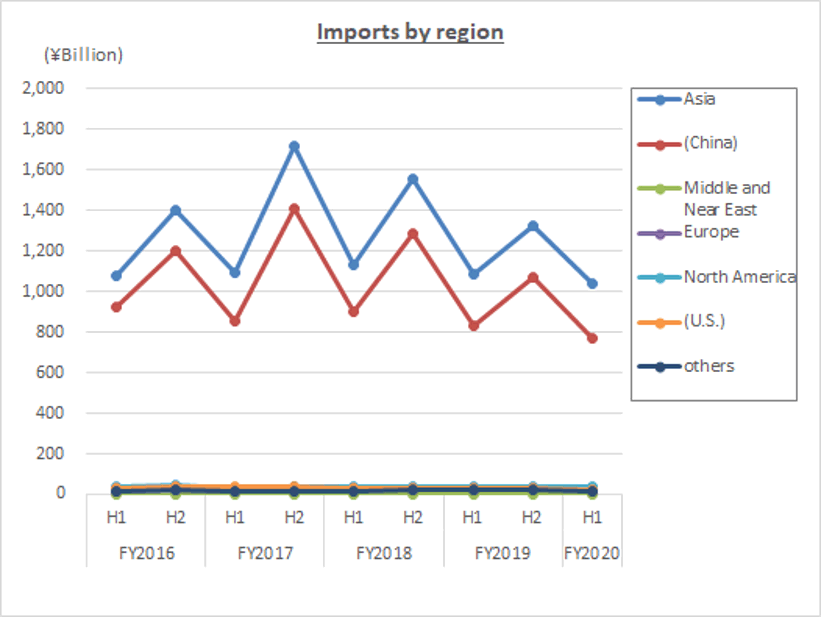The Communications and Information network Association of Japan (CIAJ) announces the telecommunication equipment production and trade figures for April through September, 2020 as follows.
I. Summary
The Japanese economy grew significantly in reaction to the considerable decrease due to the COVID-19 pandemic, with an annual GDP growth rate of 22.9% (second preliminary figures for July to September: December 8) in April through September 2020. However, it has not yet returned to the level before the spread of the COVID-19, and there is movement toward recovery amid this severe environment where we are striving to balance preventing the spread of COVID-19 and economic activities.
Under these circumstances, demand for network capital expenditure continues to increase in the telecommunication equipment market in line with the construction of 5G communication infrastructure and the nationwide development of optical cable networks. Yet, due to curtailed business activities and sluggish demand due to the impact of the COVID-19 pandemic, there was a decline in demand for consumer-related devices such as mobile phones and business-related devices, which account for a large proportion of the demand.
(1) Domestic Market Trends
The domestic market value (domestic production value – export value + import value, excluding components) amounted to 1,164.4 billion yen in the April through September period, a year-on-year decrease of 3.5%. The decrease was caused by a fall in total imports.
(2) Domestic Production Trends
Domestic production totaled 222.3 billion yen in April through September, a year-on-year decrease of 0.5%. Domestic production decreased for the first time in three half-year periods since the second half of fiscal 2018, as a result of a fall in the domestic production of terminal devices such as mobile phones amid the COVID-19 pandemic.
(3) Export Trends
Total exports amounted to 132.1 billion yen for April through September, which was a year-on-year fall of 16.0% and a continued decline. Smartphone shipments in emerging countries in Asia peaked and exports of components for smartphone production decreased. Also, overseas economies slowed due to the COVID-19 pandemic. As a result, exports have decreased in five consecutive half-year periods.
(4) Import Trends
In the April through September period, total imports amounted to 1,120.2 billion yen, a 4.3% decrease year on year. While domestic demand related to networks remains strong, total imports have decreased for four consecutive half-year periods, reflecting a fall in mobile phones, which account for a large share of total imports, partly due to restrained purchasing.
II. Domestic Market Trends
(Aggregated by CIAJ based on Indices of Industrial Production and Trade Statistics of Japan)
(1) Detailed trends by category
Actual figures by category for FY2020 first half (H1) are as follows
The size of the domestic market (including the value of imports of foreign brands) was calculated from government figures, the Indices of Industrial Production and Trade Statistics of Japan, according to the following formula: Domestic market size = value of domestic production – value of exports + value of imports.
Terminal equipment : 674.3 billion yen (-15.8% over the same period of the previous year)
Network equipment : 490.1 billion yen (+20.7% over the same period of the previous year)
III. Domestic Production
(Aggregated by CIAJ based on Indices of Industrial Production compiled by the Ministry of Economics, Trade and Industry)
(1) Detailed trends by categories
Actual figures by category for FY2020 first half (H1) are as follows:
Wireline terminal equipment
20.3 billion yen (-18.9% over the same quarter of the previous year). Of this, telephone sets was 0.9 billion yen (-8.5% over the same period of the previous year), push-button telephones 6.3 billion yen (-8.3%), and intercoms 13.2 billion yen (-23.8%). Demand for intercoms and push-button telephones decreased significantly due to a decline in buyers’ motivation amid the spread of COVID-19 and delays in starting the construction of housing and office buildings.
Mobile terminal equipment
75.7 billion yen (-7.0% over the same period of the previous year). Of which, mobile phones was 52.1 billion yen (-9.5% over the same period of the previous year). Demand for mobile phones weakened and domestic production decreased chiefly due to a decline in buyers’ motivation amid the spread of the COVID-19 coronavirus and restrained purchasing before the release of 5G terminals.
Wireline network equipment
73.0 billion yen (+20.9% over the same period of the previous year). Of this, central office switching systems was 7.3 billion yen (+ 90.5% over the same period of the previous year), private branch exchanges (PBXs) was 1.4 million yen (-56.6% over the same period of the previous year), digital transmission equipment was 32.7 billion yen (+55.7% over the same period of the previous year) and other transmission equipment was 28.3 billion yen (-3.3% over the same period of the previous year). Domestic production of private branch exchanges decreased considerably, reflecting a decrease in opportunities to use fixed line telephones and a reduction in offices due to an increase in working from home. Domestic production of digital transmission equipment continues to increase due to strong demand for backbone network equipment, in line with the construction of 5G telecommunication infrastructure and the nationwide development of optical cable networks.
Wireless network equipment
27.9 billion yen (+10.6% over the same period of the previous year). This includes 10.6 billion yen (-10.0% over the same period of the previous year) for fixed telecommunication devices and 17.3 billion yen (+28.5% over the same period of the previous year) for base station communication equipment. While domestic production of fixed telecommunication devices decreased due to sluggish private capital expenditures, domestic production of base station communication equipment continues to increase for the construction of 5G communication infrastructure.
Network access equipment
13.4 billion yen (-24.6% over the same period of the previous year). Because of the COVID-19 pandemic, network traffic increased due to teleworking and online meetings, and demand for telecommunications carriers and government offices is strong. However, domestic production of network access equipment decreased year on year owing mainly to a decrease in capital expenditures by private companies and a drop in unit prices due to intensifying price competition.
Wireline parts (relays and repeaters for wired equipment)
12.0 billion yen (-11.9% over the same period of the previous year). Component production continues to decline due to a fall in the exports of components for smartphones manufactured overseas.
IV. Exports
(Compiled by CIAJ, based on Ministry of Finance’s “Trade Statistics”)
(1) Detailed trends by categories
Actual figures by category for FY2020 H1 are as follows:
Telephone sets and terminal equipment9.2 billion yen (-23.6% over the same period of the previous year).
Of this, mobile phones was 7.5 billion yen (-29.7% over the same period of the previous year), cordless handsets for landline phones was 120 million yen (+6.5% over the same period of the previous year), and other was 1.6 billion yen (+23.0% over the same period of the previous year). Mobile phones continued to decrease due to the impact of the overseas economic downturn.
Network equipment48.9 billion yen (-18.5% over the same period of the previous year).
Of which, base stations were 400 million yen (-67.3% over the same period of the previous year), data communication equipment was 47.3 billion yen (-16.3% over the same period of the previous year) and other network equipment was 1.2 billion yen (-46.2% over the same period of the previous year). Exports of data communication equipment have been sluggish due to a significant decrease in demand caused by a slowdown in the overseas economies.
Parts (both wireline and wireless)74.0 billion yen (-13.2% over the same period of the previous year)
Although the value of exports decreased to one-third of that of maximum exports, exports are picking up due to increasing demand for 5G-related parts and those for data centers.
(2) Detailed trends by region
The results by region for the April through September period include 81.9 billion yen for Asia (-14.8% over the same period of the previous year), in which exports to China totaled 24.1 billion yen (-27.6% over the same period of the previous year). North America was 32.2 billion yen (-10.6% over the same period of the previous year), of which the U.S. was 31.7 billion yen (-10.9% over the same period of the previous year). Europe was 14.4 billion yen (-27.7% over the same period of the previous year), of which the EU was 10.6 billion yen (-38.1% over the same period of the previous year). The percentage of exports to China in total exports further decreased to 18.3% due to trade and other issues. In addition, exports to the United States and Europe, where there is concern about the spread of the COVID-19 coronavirus accelerating again, are declining.
(3) Comparison and breakdown by region
| First: | Asia | 62.0% (+0.8% over the same period of the previous year) |
| Second: | North America | 24.3% (+1.4% over the same period of the previous year) |
| Third: | Europe | 10.9% (-1.7% over the same period of the previous year) |
| Other regions: | 2.8% (-0.5% over the same period of the previous year) |
V. Imports
(Compiled by CIAJ, based on Ministry of Finance’s “Trade Statistics”)
(1) Detailed trends by categories
Actual figures by category for FY2020 H1 are as follows:
Telephone sets and terminal equipment587.5 billion yen (-16.8% over the same period of the previous year)
This includes 581.6 billion yen for mobile phones (-17.0% over the same period of the previous year), 2.3 billion yen for cordless phones (-2.2% over the same period of the previous year), and 3.6 billion yen for other products (+9.4% over the same period of the previous year). With regard to mobile phones, imports of smartphones decreased, reflecting a fall in demand due to restrained purchasing and other factors as well as new products from overseas manufacturers which were released in a different month in the previous year.
Network equipment424.7 billion yen (+17.1% over the same period of the previous year)
This includes 37.4 billion yen for base stations (+84.4% over the same period of the previous year), 377.8 billion yen for data communication equipment (+13.4% over the same period of the previous year), and 9.5 billion yen for other network-related apparatuses (+3.5% over the same period of the previous year). Imports of switching equipment and routing equipment as well as “other products (transmission equipment, communications equipment, modems, etc.)” in data communication equipment increased due to growth in demand for network capital expenditure.
- Parts (both wireline and wireless)108.0 billion yen (+6.6% over the same period of the previous year)
(2) Detailed trends by region
The results by region for the April through September period include 1,043.2 billion yen from Asia (-4.1% over the same period of the previous year), in which imports from China totaled 771.3 billion yen (-7.6% over the same period of the previous year). North America was 28.4 billion yen (-21.2% over the same period of the previous year), of which the U.S. accounted for 26.0 billion yen (-23.5% over the same period of the previous year). Europe was 31.0 billion yen (+36.4% over the same period of the previous year), of which the EU was 30.5 billion yen (+39.1% over the same period of the previous year). Regarding imports from Europe, imports of parts (up 126.8%) and base stations (up 1,116.0%) are increasing.
(3) Comparison and breakdown by regions
| First: | Asia | 93.1% (+0.1% over the same period of the previous year) |
| Second: | North America | 2.5% (-0.6% over the same period of the previous year) |
| Third: | Europe | 2.8% (+0.9% over the same period of the previous year) |
| Other regions: | 1.6% (-0.4% over the same period of the previous year) |
VI. Trends in Orders Received and Shipped
(1) Results for the first half of FY2020 (April through September 2020)
CIAJ statistics for total orders received and shipped in April through September amounted to 660.6 billion yen, representing a decrease of 12.2% year on year. This includes 547.4 billion yen for domestic shipments, which fell by 8.5% year on year, and 113.1 billion yen for exports, which dropped 26.6% year on year.
*CIAJ statistics for total orders received and shipped = orders received and shipped by CIAJ member companies in Japan
(=value of shipments for the domestic market (domestic production + foreign production) + value of exports = value of domestic production + value of imports of products produced abroad)
(2) Trends by category
Actual figures by category for FY2020 H1 are as follows:
Wireline terminal equipment 218.1 billion yen (-19.3% over the same period of the previous year)
Overall orders for wireline terminal equipment received and shipped fell significantly year on year, reflecting a decrease in domestic demand for cordless phones and intercoms due to the impact of the coronavirus pandemic, as well as a fall in the exports of home use fax machines (including multifunction home use fax machines) and business use fax machines (including multifunction business use fax machines).
Mobile terminal equipment 196.2 billion yen (-8.6% over the same period of the previous year)
Demand for mobile phones was sluggish, principally due to restrained purchasing. Exports of other mobile terminal apparatuses (wireless systems for disaster control, commercial use, etc.) were strong.
Wireline network equipment 110.8 billion yen (+8.0% over the same period of the previous year)
Orders for business-related devices such as push-button telephones and private branch exchanges dropped, reflecting the decreased use of land lines and reduced offices due to teleworking, impacted by work style reforms during the COVID-19 pandemic. On the other hand, orders for wireline network equipment as a whole increased year on year thanks to continued strong demand for digital transmission equipment and PON/MC in Japan.
- Wireless network equipment 106.4 billion yen (-17.7% over the same period of the previous year)
Although demand for base station communication equipment used for mobile phones is increasing ahead of the commercialization of 5G services, overall orders for wireless network equipment decreased year on year due to a considerable decline in demand for terrestrial communication equipment for public offices and the private sector and satellite communication equipment for public offices, demand for which was high in the same period of the previous year.
- Other network equipment 16.5 billion yen (-23.4% over the same period of the previous year)
Despite the unchanging level of orders for routers, orders for LAN switches decreased significantly due to sluggish private capital expenditure. As a result, orders for other network equipment as a whole decreased year on year.
- Communication equipment parts 12.6 billion yen (-11.2% over the same period of the previous year).

